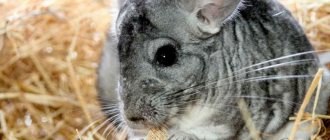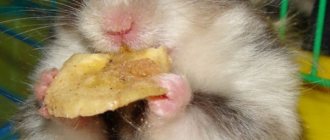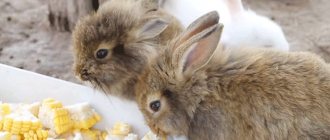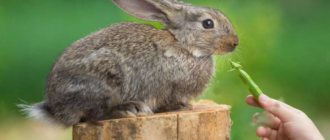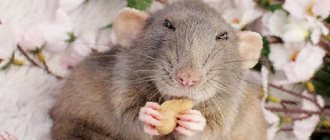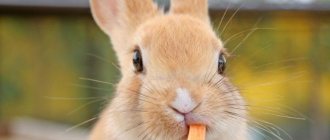How do rabbits react to walnuts?
Let's continue the topic of treats for our eared friends today. It's no secret that walnuts are always loved and desired by rabbits
. To be precise, they are not interested in the nuts themselves, but only in the internal contents, that is, the kernels. The rabbit is simply not able to get the core of the fruit on its own. He will roll on the floor until he gets tired, or even won’t pay any attention at all.
Will there be any harm to the health of our pets from eating this exotic fruit? It all depends on the amount eaten. A safe norm is one nut per day. This is if you just decided to please the rabbit one time. It is not worth feeding on a regular basis.
One nut kernel contains so much vegetable protein and fat that daily consumption can lead to an imbalance in the digestive system.
In terms of protein, walnuts can compete with meat.
Oversaturation of the body with calories has a very bad effect. In general, too much fat in a rabbit that is in a resting period leads to obesity, and the liver will work for wear and tear.
.
Who will like it if females stop getting pregnant, and males go on indefinite leave ahead of time. Still, our animals are herbivores and we shouldn’t forget about it. One nut every three days will be enough.
On the contrary, I give lactating females one nut kernel every day.
This will immediately affect milk production, its fat content, and therefore the growth rate of suckling rabbits. Microelements, especially calcium, play an equally important role for the lambing rabbit. She lost a lot of it during pregnancy and is losing it every day with every drop of milk. No less important: potassium, phosphorus, magnesium.
Walnuts are very rich in vitamins. A luxurious “bouquet” of all kinds of vitamins: A, C, E, P and the entire group of B vitamins will overshadow commercially available complex vitamin preparations and supplements.
To restore strength after a debilitating illness
, the same coccidiosis, walnuts will be very useful.
In this case, I feed them daily for a week
, or even longer, depending on the degree of recovery.
Since we’re talking about this unpleasant disease, I’ll add that coccidia, the simplest microorganisms, simply “shy away” from the presence of iodine. This is their nature. Therefore, rabbit breeders use water for prevention - drinking water with the addition of a drug containing it. But walnuts contain large quantities of iodine and therefore they are an excellent preventative
.
Some of my colleagues practice distributing walnut branches and leaves for the purpose of such prevention. In addition, in case of any internal intestinal or stomach ailments, they help their healing, being a natural antiseptic
. It's hard to argue with that. But I am somewhat skeptical about reports that these leaves protect against the hemorrhagic virus. Please express your point of view on this issue in the comments if you have experience.
Although in this case there are still contraindications due to the fact that the nut leaves contain tannins. A rabbit, having eaten them, out of habit, can get severe constipation, just like after eating oak leaves. Bitterness from greens will also affect the taste of commercial rabbit meat.
In my practice, I often use walnuts not only because they are very healthy. With their help, it is easier to find mutual understanding with a newly arrived rabbit on the farm.
. So that he considers me his best friend, I always give him something tasty, including walnuts.
Keepers of domestic decorative animals know how often the animals are offended by some actions on our part. They shy away, are afraid, are jealous, or even hide somewhere under the sofa or under the bathroom. To make amends and make friends again, a treat in the form of a nut will help a lot. The main thing is to know when to stop, because a rabbit can easily gnaw off even a dozen for a sweet soul.
What fruit tree leaves can be added to the diet of rabbits?
Balanced food for domesticated rodents is the primary task of rabbit breeders who breed furry animals. Is it possible to give tree leaves to rabbits?
Is it possible to give leaves to rabbits?
Green complementary foods are a source of nutrients and vitamins that are necessary for the growth of rodents. Even experienced farmers are afraid to add walnut leaves to young rabbits’ feeders. What leaves can be fed to rabbits?
Green food for rabbits
Farmers give walnut leaves to rabbits at their own peril and risk.
Young leaves are a real storehouse of vitamins, but not all types of leaves are beneficial to animals. Rodents living in cages or enclosures are very demanding when it comes to food. Experienced rabbit breeders add only high-quality food to the rodent feeder and select vitamin supplements especially carefully. Leaves of turnips, sunflowers, tomato stems after harvesting tomatoes or Jerusalem artichoke - what can you feed to rodents?
The farmer provides not only dry food, rich in beneficial microelements, but also dry grass in winter or fresh herbs in summer. Lettuce leaves help babies quench their thirst in especially hot weather, and beet stems strengthen the immunity of rodents. If a rabbit breeder does not provide specialized nutritional supplements to furry animals, the furry animals quickly weaken and may eventually become ill. Is it possible to give rabbits leaves from vegetables and trees that grow in any vegetable garden or farmer's garden? An experienced rabbit breeder does not give anything to his pets, otherwise mass diseases cannot be avoided.
Twig food is a special treat for rodents, but greenery alone will not keep a herd of rabbits satisfied. Even in summer, you cannot feed animals only grass. A balanced diet is the basis; the health of all residents of the enclosure depends on it. Every farmer, even a beginner, should know what pet furry dogs can and cannot eat. Without the proper diet, adults will not be able to produce offspring, and their fur will not be able to be sold in the future. What can and cannot be added to a rabbit's feeder?
What can you give small rabbits to eat?
Little rabbits are very delicate; not all foods that are suitable for adults are suitable for them. For approximately three weeks, the animals feed on mother's milk or artificial formula. Is it possible to give cow's milk to baby rabbits when their mother does not feed them for one reason or another? In principle, babies tolerate it well, in the first week they need about a milliliter per feeding, in the second week the portion is slightly increased. Many livestock breeders advise giving goat's milk or infant formula instead of cow's milk in a slightly higher concentration than what is written in the instructions.
From the age of two weeks they begin to give complementary foods. At first, it is advisable to give the rabbits only fine, delicate hay. Is it possible to give chamomile to rabbits at this age? Yes, they will be happy to eat this flower, it will be useful to them. You can include a small amount of herbal pellets in the diet, approximately 3% of the total weight.
I’m very interested in whether they give carrot tops to animals? While they are small and live with their mother, it is better to make small portions for them. After three months you can give larger portions. Carrot root is given a little earlier than three months.
From approximately three weeks of age, mixed feed or grains are added to the feeding. Cereals for rabbits at this age are steamed with boiling water; they should not make up the majority of the diet. Give grain in the morning, no more than two tablespoons. Juicy food is given after three months. Baby rabbits definitely need enough water, otherwise they may die. Sometimes it is recommended to add iodine to your water, but this is not necessary unless you live in a region with a deficiency of this element.
Tree leaves for animals
Leaves can be given to rabbits, but only in limited quantities and only a few times a week. Daily green complementary foods will only be useful together with dry mixtures. The diet of the female rabbit is especially important in anticipation of the offspring. Females are transferred to a separate diet, which should also include green complementary foods.
Leaves from trees provide free food that can be harvested in minutes. Profitable complementary foods can dilute expensive mixtures, but giving any leaves is also not worth it. What does an experienced rabbit breeder give to rabbits? Not only leaves, but also branches are placed in the rodent feeder. The structure of the lower and upper jaws of furry animals allows them to crush solid food. There is no need to worry about rodents' teeth.
How are the leaves prepared?
Having decided which leaves can be given to rabbits, you need to make sure that the animals have access to them during the cold season. You will need to work hard and prepare plants in the summer. Moreover, the collection itself takes a day or two, depending on the number of livestock.
Nettle, horseradish, and carrot leaves are excellent. They are indispensable for making mash in winter - they are perfectly stored and retain useful substances. Dry the plants in a place where direct rays of the sun do not reach. It is advisable that it be shady, but dry and well ventilated.
If you decide to collect branches and leaves from trees, it is better to do this at the end of June, maximum in early July. At this time, the leaves are already well formed, juicy, but not yet dusty and have not collected harmful substances from the environment. Brooms are knitted from the branches, as for a bath, and dried under the same conditions as other plants.
You can also pick up fallen leaves, but carefully inspect them to ensure they are free from dirt and rot.
What can and cannot be given to rabbits
The farmer must know what plants can be given to rabbits, and what should be kept away from the furries so as not to harm the rodents. There will be no harm from raspberries or currants, but the juice of some vegetables or trees is harmful and dangerous. Before putting twigs in the feeder, the person sorts through the greens again. What plants will help strengthen the body of rabbits?
The leaves of the trees are not just nutritious, they have medicinal properties. If a farmer gives green food to all rabbits, the herd gets sick less and can more easily withstand sudden temperature changes. The leaves of the trees help against various diseases; domestic rodents can suffer from them. Helping rabbits get rid of tree leaves is as follows:
- Walnut leaves help against diarrhea (loose stools) and various digestive system disorders. To treat rodents, you will need broken walnut leaves that have just begun to grow. Old stems are less nutritious and healthy. Walnuts can be used to make dried food for the winter.
- Oak leaves are needed to destroy bacterial diseases. The bactericidal properties of tannins are used to treat humans and are suitable for rabbits. Using oak branches you can prevent infectious diseases in rabbits.
- Coniferous branches are needed to maintain the immunity of rabbits. Coniferous branches are used in the winter season, when problems arise with other greenery. The vitamins contained in pine needles help strengthen the rodent’s body’s defense mechanisms. Maple leaves or crushed strawberry stems have similar properties.
- Grass that will protect rabbits from any diseases grows in the fields. You can feed rodents with carrot tops, yarrow and plantain. You can prepare such grass in the summer and give it to rodents in dried form along with dry mixtures in the winter. Herbs strengthen the immunity of rodents and help them survive the cold season.
Use oak branches, rhubarb, alder and willow in limited quantities.
Green complementary foods will help animals overcome illness or improve the functioning of the digestive system, but such leaves cannot be given constantly. Healthy green complementary foods can harm rodents, especially young animals that have not had time to grow stronger.
The animal world is designed in such a way that a plant that is found in the forest or fields helps rodents get rid of infections or bacterial diseases. The necessary green food is not difficult to obtain, and a prudent farmer stocks up on this type of supplement in the summer. For convenience, the branch is ground, and the leaves are dried and placed in small dry boxes.
Water and additional microelements
Rodents also need water. One animal drinks approximately 250-350 milliliters of liquid per day. The water in the drinking bowl should always be fresh. Sometimes they ask whether it is possible to give rabbits snow instead of water in winter. In principle, this method of watering is acceptable, but it should be borne in mind that snow contains less salts and trace elements that animals need than water.
What can you add to water? To prevent animals from getting sick, they give iodine. This will serve as a prevention of intestinal infections, and will also replenish the deficiency of the element in regions with its deficiency. It is recommended to carry out prophylaxis once every six months for two weeks. Iodine will be useful during lambing so that babies and females do not get sick. Treatment with iodine for intestinal infections will also be effective. Give iodine for diarrhea and bloating.
Sometimes it is recommended to sprinkle salt into the water. The calculation is approximately 5 grams per eight or ten liters. What kind of salt should I give to animals? They recommend regular, table, or sea. Salt is also added to the water in larger quantities to soak food in it. Water with salt will be useful in winter if you feed the animals with melted snow during this period.
Undoubtedly, livestock breeders would like to know whether it is necessary to give salt to rabbits and in what way? It is believed that animals need salt, so it is often recommended to put a salt lick in the cage. This is a small pebble that is hung on a string from the ceiling or placed near the feeder. Is it useful to know what kind of salt should be given to rabbits? So, in addition to ordinary salt, you can place a chalk stone and compact balls of bone meal in the cage. This way the animals will receive more microelements.
It is useful to know if salt lick is given to small animals, will it harm them? So, young animals will also benefit from salt pebbles, because its composition is no different from that offered to adults. Don't forget about vitamins too. There are a lot of them in green and succulent food, especially in late spring and summer. What to do in winter? Very often during this period, animals lose their appetite and lose weight. This means they lack vitamins. Special medications should be added to the diet.
Contraindications for rodents
For more tasty complementary foods, rabbit breeders experiment with greens and add branches, which, although tasty, are not very healthy for rabbits. Toxic substances cause symptoms of poisoning in rodents; the weakest rabbits may even die. Under no circumstances should elderberries, bird cherry or buckthorn be placed in the feeder of furry animals. Wolf berries and lilacs are poisonous to adult rodents and young animals.
Stone fruit trees can also cause disease in weak rabbits. The rodent's body does not accept radish greens well, but root vegetables will only benefit the animals. Side effects from taking greens include digestive upset and diarrhea.
What fruit tree leaves can be added to the diet of rabbits?
Balanced food for domesticated rodents is the primary task of rabbit breeders who breed furry animals. Is it possible to give tree leaves to rabbits?
Is it possible to give leaves to rabbits?
Green complementary foods are a source of nutrients and vitamins that are necessary for the growth of rodents. Even experienced farmers are afraid to add walnut leaves to young rabbits’ feeders. What leaves can be fed to rabbits?
Vitamins and minerals in nuts
| Nut type | Important Nutrients |
| Almond | Calcium and vitamin E |
| Cashew | Iron |
| Hazelnut | Potassium, vitamin E and folic acid |
| Pecans | Antioxidants |
| pine nuts | Vitamin E and amino acid arginine |
| Pistachios; | Potassium, protein, resveratrol (antioxidant) and plant sterols |
| Brazilian nut | Selenium |
Green food for rabbits
Farmers give walnut leaves to rabbits at their own peril and risk.
Young leaves are a real storehouse of vitamins, but not all types of leaves are beneficial to animals. Rodents living in cages or enclosures are very demanding when it comes to food. Experienced rabbit breeders add only high-quality food to the rodent feeder and select vitamin supplements especially carefully. Leaves of turnips, sunflowers, tomato stems after harvesting tomatoes or Jerusalem artichoke - what can you feed to rodents?
The farmer provides not only dry food, rich in beneficial microelements, but also dry grass in winter or fresh herbs in summer. Lettuce leaves help babies quench their thirst in especially hot weather, and beet stems strengthen the immunity of rodents. If a rabbit breeder does not provide specialized nutritional supplements to furry animals, the furry animals quickly weaken and may eventually become ill. Is it possible to give rabbits leaves from vegetables and trees that grow in any vegetable garden or farmer's garden? An experienced rabbit breeder does not give anything to his pets, otherwise mass diseases cannot be avoided.
Twig food is a special treat for rodents, but greenery alone will not keep a herd of rabbits satisfied. Even in summer, you cannot feed animals only grass. A balanced diet is the basis; the health of all residents of the enclosure depends on it. Every farmer, even a beginner, should know what pet furry dogs can and cannot eat. Without the proper diet, adults will not be able to produce offspring, and their fur will not be able to be sold in the future. What can and cannot be added to a rabbit's feeder?
Can rabbits eat off the table?
Feeding these animals with leftover food is quite popular, but not everything is allowed for them. The list of permitted products is not that long. You should know that animals should not be given meat. Also, the food should not be sour, it should be no more than two days old.
Crackers
Are they given to rabbits? Yes, because they eat dry bread with pleasure and benefit from it. You just need to be careful to make sure there is no mold on the crackers. They also ask, are rabbits allowed porridge? In principle, it is possible if it does not contain seasonings and spices. Animals will benefit from porridge if it is prepared specially. The porridge should also be mixed with whole raw grains, peas or mixed feed.
You can add some succulent food there. Small pets can be fed porridge or cereal grains steamed with boiling water. Useful food for furry animals would be oil cake and macadamia. These products are especially good at replenishing nutritional deficiencies in winter.
Eggs
Eggs
Are eggs recommended for rabbits? In principle, this is not a very typical diet for a rodent, although the egg contains a lot of protein, and the yolk is rich in microelements, some vitamins, healthy fats and amino acids. A rabbit can eat eggs with pleasure if it lacks protein food. For example, he cannot tolerate legumes, which are his main source of proteins.
Snooze
Descended from the table is suitable as an additional feed. It will not cover all the needs of animals, because they need hay, greens, cereals and grains, and succulent food. If there is no opportunity to get a large amount of green and succulent food, try to give the animals carrot tops, peas, lettuce and other vegetable waste. They will be healthier than leftover food from your table. Animals should not eat red beets or their trimmings, because they cause diarrhea.
Tree leaves for animals
Leaves can be given to rabbits, but only in limited quantities and only a few times a week. Daily green complementary foods will only be useful together with dry mixtures. The diet of the female rabbit is especially important in anticipation of the offspring. Females are transferred to a separate diet, which should also include green complementary foods.
Leaves from trees provide free food that can be harvested in minutes. Profitable complementary foods can dilute expensive mixtures, but giving any leaves is also not worth it. What does an experienced rabbit breeder give to rabbits? Not only leaves, but also branches are placed in the rodent feeder. The structure of the lower and upper jaws of furry animals allows them to crush solid food. There is no need to worry about rodents' teeth.
Cheap food is also extremely high in calories. Branch food for rabbits contains many active substances, proteins and vitamins. Dried leaves remain beneficial to rodents throughout the year. A prudent farmer who has prepared greens in the summer provides healthy food for rabbits all year round. Dried branches contain up to 40 g of protein, which is especially beneficial for furry animals in winter.
How to prepare leaves
Leaf food is easy to prepare. In eight hours in the forest, one person can collect from one and a half to two tons. This amount will be enough for a small livestock throughout the winter. Harvesting branches of deciduous trees is best done in June and July. The leaves at this time are juicy, fully formed, and contain the most protein and fiber.
Tree pruning waste can be used as foliage and twig food. For example, grapes are pruned twice a year, in spring and mid-autumn. Leaves and twigs can be safely fed to rabbits. The same can be said about apple trees, pear trees, and raspberries. Spring branches with newly opened buds are especially useful, as they contain a lot of vitamins and biologically active substances.
In autumn you can harvest fallen leaves. They must be fresh, without rot. They are collected in baskets and then dried in well-ventilated rooms. It is better not to give freshly collected leaves to animals; they contain too much moisture. Some livestock breeders advise harvesting after the first frost, but during this period the leaves are often already rotten. But such food cannot be given to rabbits.
What can and cannot be given to rabbits
The farmer must know what plants can be given to rabbits, and what should be kept away from the furries so as not to harm the rodents. There will be no harm from raspberries or currants, but the juice of some vegetables or trees is harmful and dangerous. Before putting twigs in the feeder, the person sorts through the greens again. What plants will help strengthen the body of rabbits?
The leaves of the trees are not just nutritious, they have medicinal properties. If a farmer gives green food to all rabbits, the herd gets sick less and can more easily withstand sudden temperature changes. The leaves of the trees help against various diseases; domestic rodents can suffer from them. Helping rabbits get rid of tree leaves is as follows:
- Walnut leaves help against diarrhea (loose stools) and various digestive system disorders. To treat rodents, you will need broken walnut leaves that have just begun to grow. Old stems are less nutritious and healthy. Walnuts can be used to make dried food for the winter.
- Oak leaves are needed to destroy bacterial diseases. The bactericidal properties of tannins are used to treat humans and are suitable for rabbits. Using oak branches you can prevent infectious diseases in rabbits.
- Coniferous branches are needed to maintain the immunity of rabbits. Coniferous branches are used in the winter season, when problems arise with other greenery. The vitamins contained in pine needles help strengthen the rodent’s body’s defense mechanisms. Maple leaves or crushed strawberry stems have similar properties.
- Grass that will protect rabbits from any diseases grows in the fields. You can feed rodents with carrot tops, yarrow and plantain. You can prepare such grass in the summer and give it to rodents in dried form along with dry mixtures in the winter. Herbs strengthen the immunity of rodents and help them survive the cold season.
Use oak branches, rhubarb, alder and willow in limited quantities.
Green complementary foods will help animals overcome illness or improve the functioning of the digestive system, but such leaves cannot be given constantly. Healthy green complementary foods can harm rodents, especially young animals that have not had time to grow stronger.
The animal world is designed in such a way that a plant that is found in the forest or fields helps rodents get rid of infections or bacterial diseases. The necessary green food is not difficult to obtain, and a prudent farmer stocks up on this type of supplement in the summer. For convenience, the branch is ground, and the leaves are dried and placed in small dry boxes.
Additional diet
- Wild herbs (plantain, nettle, dandelion, burdock, shepherd's purse, rapeseed, chamomile, alfalfa, mouse pea, yarrow, fireweed, chicory, wheatgrass, chickweed, clover, etc.).
When harvesting (cutting, drying, wilting) herbs and preparing a herbal mixture, you should be careful not to get dangerous plants (quinoa, nightshade, celandine, hemlock, dope, horse sorrel, etc.) into the feed, as well as plants containing essential oils (parsley, dill and etc.).
- Wormwood and tansy can be present in the diet of animals, but their quantity should be limited. Different types of herbs can be alternated when feeding or made into a green collection.
- Vegetables (white cabbage, rhubarb, potatoes, carrots, cucumbers, zucchini, tomatoes). You can also give rabbits lettuce leaves, beet tops, as well as turnip tops, Jerusalem artichoke, radishes and carrots.
- Melons (pumpkin, melon, watermelon).
- Cereals (corn, barley, wheat, oats).
- Legumes (soybeans, lentils). It is advisable to introduce legumes into the diet gradually so as not to provoke intestinal disorders. The ideal combination is a mixture of legumes and cereals.
- Fruits and dried fruits (apples, pears), except exotic and stone fruits (plum, apricot, etc.). In this case, the core of the fruit containing small seeds must be removed from apples and pears.
- Leaves and shoots of trees and garden shrubs.
Contraindications for rodents
For more tasty complementary foods, rabbit breeders experiment with greens and add branches, which, although tasty, are not very healthy for rabbits. Toxic substances cause symptoms of poisoning in rodents; the weakest rabbits may even die. Under no circumstances should elderberries, bird cherry or buckthorn be placed in the feeder of furry animals. Wolf berries and lilacs are poisonous to adult rodents and young animals.
Stone fruit trees can also cause disease in weak rabbits. The rodent's body does not accept radish greens well, but root vegetables will only benefit the animals. Side effects from taking greens include digestive upset and diarrhea.
What can you feed rabbits?
The diet of long-eared rodents should be varied. They have a sensitive digestive system, so the rabbit menu does not include food from the human table. The animal diet includes 4 types of feed:
Every farmer and breeder should know what these feeds include. Otherwise, health problems for pets cannot be avoided.
Roughage
This group includes hay and twig food. Rough food makes up 25% of the diet in summer and 30-35% in winter. Rabbits' incisors are constantly growing, and dried grass and branches help to grind them down.
Hay is always stored for the winter. An adult will need 40 kg of dried grass. It is collected in the summer before the flowering phase begins. The composition of hay includes different plants:
- meadow grasses;
- steppe forbs;
- legumes;
- tops
If there is a lack of quality hay, males are supplemented with straw. The more valuable product is left for lactating and pregnant females and rabbits. Eating dry grass has a beneficial effect on the digestion process. It is correct to store hay stocks in a well-ventilated area, otherwise mold will form in it . The fungus causes severe poisoning in rodents.
Branch food is another component of the diet that should not be neglected. Branches of trees and bushes contain useful substances. Raspberry shoots, plum branches, willow, maple, aspen and acacia are suitable for food for rabbits.
Attention! The shoots of some trees are prohibited from being given to rabbits as they contain poison. These include wild rosemary, sumac, broom, and elderberry.
Juicy feed
This group includes vegetables and root crops, as well as silage. Juicy foods contain vitamins and microelements, but they contain almost no protein, calcium and phosphorus. This type of food has low nutritional value.
Rabbits' favorite treat is carrots. It is rich in retinol and B vitamins. It is included in the menu from the age of one month, offered to babies in crushed form. You can also feed rabbits:
- fodder beet;
- zucchini;
- Chinese cabbage;
- broccoli;
- turnip;
- Jerusalem artichoke;
- pumpkin
Attention! Red beets cause intestinal upset and should not be fed to rodents.
Green food
This group includes all kinds of herbaceous plants and tops of garden crops. Green food dominates the animal menu in summer. It makes up a third of the diet. Meadow and weed grasses contain many vitamins, micro- and macroelements. Legume stems are enriched with protein.
Rabbits can be fed:
- stems and leaves of nettle;
- dandelion;
- burdocks;
- plantain;
- yarrow;
- Vikoy;
- alfalfa;
- wormwood (a little);
- carrot and beet tops.
Rabbits can be fed nettle stems and leaves
The grass is collected in dry weather. Plant raw materials are not given immediately; first, they are dried in the shade for 3-4 hours. Freshly cut vegetation contains ether, the concentration of which decreases with short drying.
Many farmers are looking for information about whether it is possible to feed ragweed to rabbits. In summer, this weed fills everything around, but it is not suitable for feeding pets. The herb contains a lot of bitterness and essential oil, which causes digestive problems.
Important! Do not give wet grass with drops of dew or rain to rabbits.
Concentrates
The share of concentrated food in the diet of rodents is 35–40%. This group includes grains of cereals and beans and the remains of their processing, as well as oilseeds. Compound feed also belongs to concentrates.
Rabbits enjoy eating grains:
Selection of roughage
It has already been said above that the rabbit’s diet must be varied. One feeding option is roughage. In this case, various herbs, dried straw, and thin tree branches are suitable. One of the best candidates for this type of food would be hay, because it contains a large amount of fiber, which significantly improves digestion in rabbits. Making hay is quite simple; to do this, you need to mow the grass (manually or using special equipment), preferably in a meadow where a huge number of all kinds of useful plants grow - clover, chamomile, alfalfa, peas. When collecting grass, you should mow it before flowering and carefully ensure that you do not come across plants that are poisonous to rabbits (celandine, dope, wild mustard). After everything is mowed, the harvested crop is quite simply dried in the sun, collected into sheaves and food supplies are ready.
Hay harvesting should be done at the rate of approximately 45 kg of hay per adult for wintering. It is better to store hay under a canopy, providing good ventilation, but at the same time so that it does not get wet or collect moisture. In addition, it is worth noting that hay is a fairly nutritious product, which is an important aspect when fattening rabbits. It is best to give it in late autumn and winter, when supplies of fresh grass have dried up, as well as in early spring - before fresh greenery appears. Sometimes pea or oat straw can be given instead of hay, as it contains a lot of fiber. However, rabbits do not eat it very well, and it is also poorly digestible. Therefore, it is better to give it only to adults and only on the condition that other types of food are already running out.
When you haven’t had time to prepare hay or your supplies are insufficient, another good option comes to the rescue - this is branch feed. It is considered an essential component in the diet of rabbits, and is also a fairly affordable and healthy type of food. By the way, soft twigs help rabbits grind down their teeth and avoid gnawing through the cage. To do this, you can prepare twigs from trees such as birch, linden, willow, willow, aspen, maple, poplar, ash, apple, pear, acacia, oak, alder. Branches of coniferous trees - spruce, pine, cedar - are in particular demand.
However, not all trees are worth plucking branches from. You should not give rabbits shoots of apricot trees, bird cherry, buckthorn, elderberry, wild rosemary, cherries, plums, cherries, and peach. These representatives contain toxic substances (for example, hydrocyanic acid), which can adversely affect the health of your long-eared pets. Preparation of branches should be done at the beginning of summer, cutting them off and collecting them in brooms, and also dry them thoroughly and store them in a ventilated place. In winter, if the supply of “summer” twigs runs out, spruce twigs will be an excellent option, which rabbits will eat with great pleasure. In addition, by eating branches of coniferous trees, animals' digestion improves, their fur takes on a beautiful, well-groomed appearance, becoming smoother and shiny. This type of food is universal, as rabbits can eat it all year round.
Prohibited Products
Inexperienced breeders make the mistake of offering rabbits treats from their table. Some products pose a serious danger - they cause disruption of intestinal function and even death of pets. Not all herbs are suitable for feeding fur-bearing animals. Poisonous plants are deadly. It is important to know what rabbits are not fed so as not to harm them.
Poisonous plants
Eating some herbs is associated with unpleasant consequences. Among meadow and steppe plants there are many poisonous ones. Even in small quantities they are dangerous for pets. Here is a list of herbs that are unsuitable for consumption:
- buttercup;
- hemlock;
- celandine;
- digitalis;
- hellebore;
- sleep-grass;
- pestilence saffron;
- cicuta;
- callas;
- marsh marigold;
- delphinium;
- spurge.
After eating poisonous plants, your pet may experience limb cramps, vomiting, diarrhea, and sometimes a slow heart rate, drooling, and urinary retention. Owners of rabbit farms and domestic decorative rabbits need to learn to distinguish beneficial herbs from potentially dangerous ones.
Sweets
You should not feed rabbits all kinds of sweets - sweets, cookies, buns and cakes. There is nothing beneficial for animals in such food, but there are harmful additives in the form of sugar, preservatives, dyes and thickeners. Eating sweets often leads to severe allergic reactions, intestinal upset and even death of pets.
Nuts
Rabbits should not be given nuts. Their kernels are difficult to digest. Experienced breeders warn that eating such food creates a large load on the liver and gall bladder of animals. After tasting a high-calorie treat, they suffer from vomiting and diarrhea.
Meat and sausages
Herbivorous rodents do not need meat. They get their protein from other sources. Feeding animal foods to rabbits can cause bloating and indigestion. Sausages and sausages are also prohibited products. They contain harmful additives and fat. Such food does not bring benefits.
Herbivorous rodents do not need meat
Dairy
Any food of animal origin is harmful to rodents. Little rabbits drink mother's milk for up to one and a half to two months, and after weaning from the mother rabbit, the animals have no need for this product.
Do not give to animals:
Dangerous vegetables and tops
The tops of tomatoes and peppers are not suitable for rabbits to eat. If the above-ground part of potatoes is fed to rodents, it is in small quantities. Of the vegetables, red beets are dangerous. Its pulp is aggressive; after eating the root vegetable, animals experience diarrhea and their general health worsens.
Do you need vitamins?
If the feeding rules are followed, the pet does not need additional feeding with vitamins, receiving them from balanced food, vegetables and herbs. However, in winter, a rabbit may suffer from vitamin deficiency. A complex of vitamins is prescribed by a doctor. The dosage depends on the age and size of the pet.
Competent adherence to recommendations and periodic visits to the veterinarian will help the owner ensure that their pet has a long and happy life.
Conditionally permitted food products
Some products, despite the fact that they belong to the group of permitted ones, are fed to rabbits with caution. These include fruits, berries, root vegetables, and grains.
Vegetables
Not all vegetable crops are equally beneficial for rabbits. Some of them offer pets in limited quantities, for example:
- tomatoes;
- onion;
- potato;
- red cabbage;
- radish;
- eggplants.
The listed vegetables irritate the intestinal mucosa and cause bloating. Potatoes can be given to pets, as well as peelings, but provided that there are no green fragments on the tubers. Before serving, the peel is thoroughly washed and the eyes are removed. Root vegetables are offered raw and boiled.
Fruits
Long-eared rodents can be fed with almost all types of fruits, except exotic ones, but you should not overuse them. Experienced rabbit breeders recommend treating animals with a small piece of fruit 2-3 times a week. The diet includes various fruits:
Peeled bananas for rabbits
- peeled bananas;
- melon;
- watermelon and peels;
- apricot;
- any varieties of apples;
- pear.
It is important to alternate different fruits, offering new ones each time. Before distribution, the fruits are washed and the seeds are removed.
Attention! Citrus fruits - oranges, lemons, tangerines - should not be fed to rabbits. Avocados, figs, and mangoes should be added to the list of prohibited fruits.
Berries
The same rules apply to berries as to fruits. They are given a little 2 times a week, observing the animal’s reaction. In case of diarrhea or other digestive problems, the product is excluded.
Rabbits readily eat fruits:
Grains and beans
Despite the usefulness of grains and legumes, not all of them are suitable for feeding rodents. Some foods cause bloating and pain in the intestines, others contain too much fiber, which is difficult to digest. Consider the list of unhealthy legumes and cereals:
- millet;
- rye;
- rice;
- millet;
- green pea;
- red and black beans.
It is especially important for owners of large rabbit farms to remember what they can and cannot feed their rabbits. If mistakes are made when preparing the diet, there is a high risk of losing livestock.
Various concentrated feeds and cereals
There are many different cereals that you can feed eared pets. This includes buckwheat, millet, pearl barley, rice, oatmeal and other similar products from the table. Rabbits should be fed cereals in crushed form, or they can be made into porridges (so-called mash). Porridges are suitable for both small, growing animals and adult livestock. For example, boiled rolled oats or pasta go very well. But under no circumstances should rabbits eat undercooked food or whole, unground grains.
If we talk about grain, many farmers are interested in whether rabbits can have sunflower seeds. In principle, it is those seeds that are rich in essential oils that can be given to animals not in crushed form. But it is better not to use hemp or hops (cones, stems or leaf food). They should not be given to either small or large rabbits. But wheat, rapeseed or millet are quite suitable as feed. But only in crushed form. Although adult animals consume millet in whole form.
Wheat is not the only grain that is suitable. You can feed barley, make up portions based on oats and a number of other grains. But it is better not to use sorghum for feeding - animals often have intestinal problems from such food. In principle, oat-based food is suitable for animals of any age. Rolled (not crushed) grain, boiled oatmeal or rolled oats are perfectly digestible by eared pets. But you can’t give it fried or with sugar - rabbits react poorly to sweets, as well as to fried foods.
Food mixtures and additives to the diet of rabbits
Concentrated and combined feeds are often the basis for the diet of rabbits. But the dosage and composition of the mixture are always important here. It is very important to know what is and is not included in the food, since the list of components is always available on the manufacturers’ website. And you need to understand that what rabbits can eat also depends on their age. One food is intended for rabbits that are not yet a month old, and the other mixture is given to adult animals. And you can’t confuse them with each other, otherwise there will be problems with the health of the animals.
Although, instead of some feeds, you can give hand-prepared mixtures with a similar composition. But you should always make sure that in addition to dry food ingredients there is clean water. And there must be a lot of water, because there is no animal that could do without it. The condition of the drinking bowls must be monitored with special attention to prevent clogging of the drink. And you should not add salt to the water, as is sometimes recommended. Such an additive can cause considerable harm to the animal if it is used carelessly.
And if we are already talking about mineral supplements, then we should mention that rabbits need calcium, sodium and chlorine. But there is no need to give them chalk, table salt, or put a lick in the rabbitry. It is worth looking at the list of products containing these minerals. In particular, this list includes bone meal, wheat bran and a number of other products. For example, soybeans (pulp, meal, tops and fruits) or the tops of other legumes are often given for these purposes. But you can’t give them cottage cheese or cow’s milk. Baby rabbits can only have mother's milk.
Products from the table
Some foods from the table can be given to rabbits, provided that they have not begun to rot or become moldy. For example, you can feed them pieces of stale bread. But it is better to make crackers out of bread and give it in this form. This also includes bread crusts, lettuce and peels of fruits and vegetables. But the breadcrumbs will require additional water. Rabbits need to be watered constantly, because the more they eat, the more water they will need. By the way, some owners prefer to add iodine and vitamins to the water.
Among those foods that rabbits should not eat, mushrooms are worth mentioning. Even some varieties that are harmless to humans can cause poisoning in rabbits. And here you will have to take out activated carbon from the first aid kit, if it is there, of course. You should not feed your rabbits paper (and don’t say that it can sharpen your teeth), chocolate, chicken eggs and poultry fish oil. Domestic rabbits will definitely not like them. Very often, those foods that are intended for people cannot be eaten by eared pets.
What branches can you give to rabbits?
The main food for decorative rabbits is hay and granulated food, and in summer also grass. But as a supplement to the diet, you can give rabbits branches of the following trees almost every day:
Can rabbits eat pine branches? - Yes, like other conifers, but they should not be given too often. From time to time, decorative and ordinary eared animals can also be given tree branches:
Which tree branches are suitable for rabbits - photo answer.
Branches from apple trees, hazels, and grapes can be given along with the fruits, and currants without berries. Rowan and chestnut are also without fruit, and only sometimes and in small portions. Walnut branches are given a little at a time to prevent parasites.
Birch branches have a diuretic property, willow and linden have an analgesic effect, oak and alder help with diarrhea, and coniferous branches are rich in vitamin C. Considering the listed properties, these branches are given only occasionally for prevention.
Tree branches that can be given to rabbits, but not often.
Tree branches contain vitamins, microelements, fiber and various substances that are not found in all herbs and grains. Therefore, in the correct diet for a rabbit, branches are an essential component.
Feeding standards
The feeder of a decorative rabbit should not be empty, since the consumed food moves through the intestines at the expense of the incoming one. A break in feeding leads to fermentation and rotting of feces, which can cause the death of the animal.
There is no specific rabbit feeding regimen. The main thing is to ensure the constant presence of hay, bark, branches of bushes and trees in the enclosure or cage. Twice a day, other food included in the diet of a decorative rabbit is supplied.
Important! The cage must have a drinking bowl with clean water.
